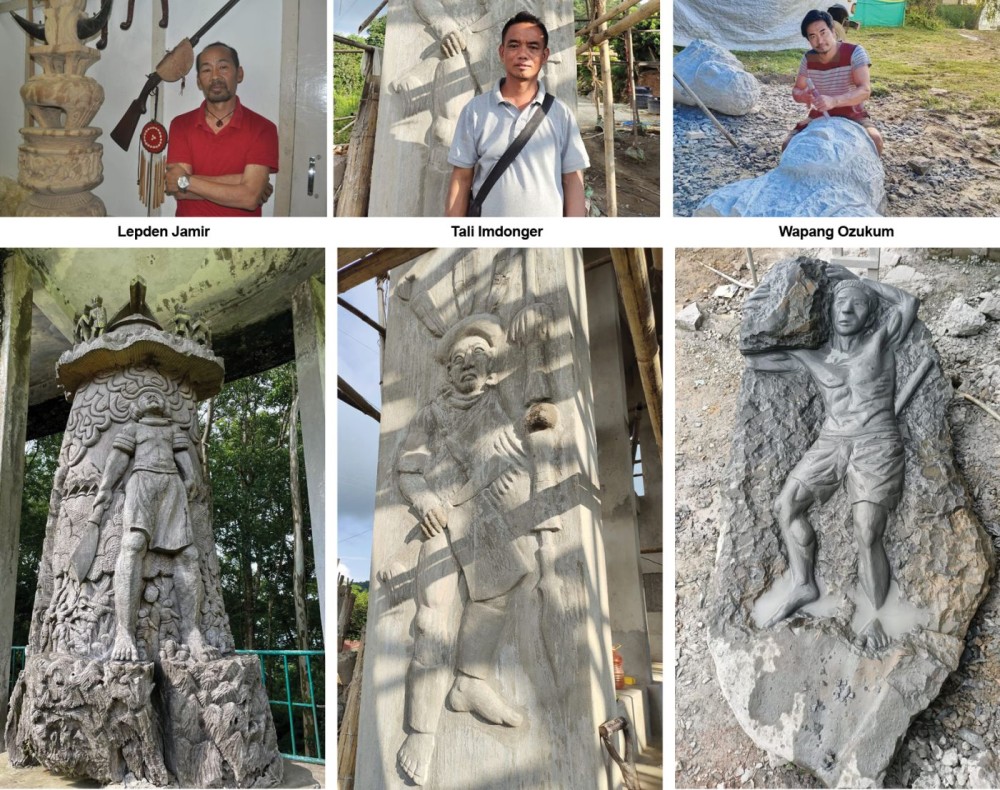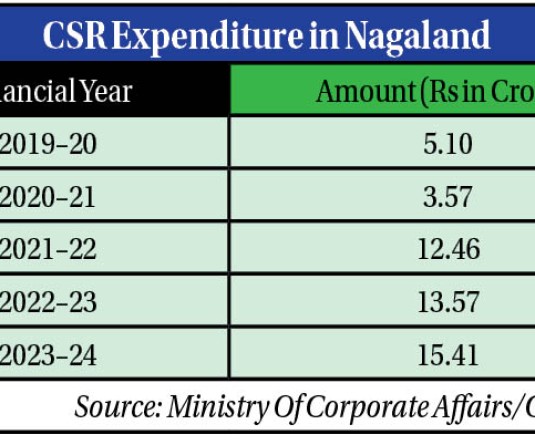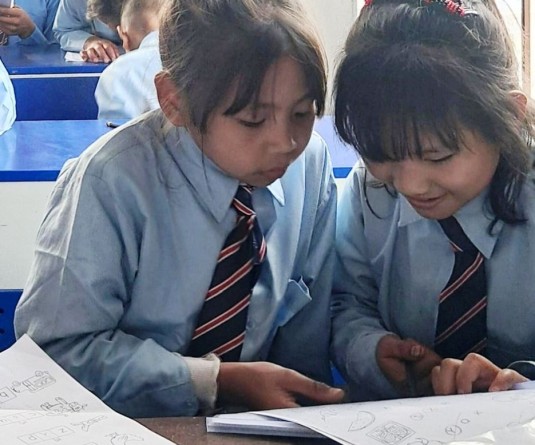(Left to right) Sculptures made by Lepden Jamir, Tali Imdonger and Wapang Ozukum respectively.

Yarden Jamir
Mokokchung | October 24
In a backyard in Mokokchung town, the sharp rhythm of chisel meeting stone punctuates the still afternoon. Dust gathers in the air as fragments of rock fall away, slowly revealing the curve of a shoulder, the suggestion of a face. Here, among heaps of stones hauled in by dumper trucks, 39-year-old Wapang Ozukum works with steady patience—one strike at a time, chiselling permanence into impermanence.
For nearly two decades, Wapang has worked between stone and wood, shaping monuments, memorials, and carved doors that silently guard the thresholds of Nagaland’s history. “This kind of stonework was not known in our place,” he says, wiping his hands on a ragged cloth. “I discovered it myself.”
He remembers his first breakthrough in 2013 in Chungtia village, where he sculpted a bust of the longest-serving pastor to commemorate the church centennial. “No one taught me,” he says. “I experimented, failed, and studied until I succeeded.”
The stones he works with come from Ungma village, chosen carefully for their texture and grain. “Not every rock will do,” he explains. “It has to come from a specific part of a larger stone, dense and fine, the kind that can hold detail.” To extract them, he hires JCB excavators and transports the blocks by truck. His own home yard is too cramped for such massive undertakings, so he now works from his brother-in-law’s more spacious backyard, where two assistants from the Chang community chip away nearby. “They follow my directions,” he says, smiling faintly. “But the detailing, I must do myself.”
Since his self-taught beginnings, Wapang’s works have spread across Nagaland: monoliths, memorial busts, and public sculptures in stone and wood. His hands, calloused from both materials, carry the memory of each piece. He carved the grand entrance of Nagaland’s first medical college in Kohima, a project that kept him in the capital for nearly a year—and is now carving the main wooden door of P. Shilu Park in Mokokchung. “When you make something people will walk through every day,” he says, “it should speak to them—it must feel alive.”
Each bust or memorial takes six months or more to complete. He has made around twenty so far, including the well-known bust of Imkongmeren in Longkhum village. “You can’t take up many projects at once,” he says. “You have to be immersed 24/7. Every curve and line has to come from within.”
His persistence earned him the Governor’s Award in 2021, recognition that brought both pride and validation.
Still, Wapang remains concerned about the future. “We Nagas want white-collar jobs,” he says. “We don’t value hard labour, and parents don’t encourage their children to do this kind of dusty, dangerous work. We lack dignity of labour.”
A father to a three-year-old son, he worries that few will take up the craft. He has tried to teach youngsters, but most “lack commitment,” he says.
Even so, he continues, not for fame or profit, but for purpose. “This is my passion,” he says. “Even when there are no projects, I feel satisfied knowing I’m preserving something for the future.” His sculptures often weave traditional elements and motifs, guided by consultations with village elders. “It’s a big responsibility,” he says quietly. “I want the next generation to see our traditions carved in stone, not forgotten in time.”
Carving the Gateways of Memory
From across the valley of Longsa village, another craftsman chips away at history. Tali Imdonger, 47, is at work on a monumental gate in Khensa village, shaping human figures that will stand guard at the entrance, smiling, welcoming, and strong.
“This is what you’ll see when you leave the village,” he says, studying the half-finished faces. “So they should be good-looking and smiling,” he laughs. But at the entrances, he adds, there should be strong and fierce warriors. “The villagers even tell me not to make them small like me,” he says with a grin.
.webp)
Tali’s humour hides years of quiet perseverance. He began by carving portraits and small sculptures out of solid wood. “I had no formal training,” he says. “No teachers. Just passion.” For nearly two decades, he has built gates and monuments across Nagaland, over ten village gates, including four in the Sümi region and several in Ao areas such as Longjang, Anaki, and Longsa. Of them all, he says proudly, “The Longsa Eagle Club Monument is my best work.”
Tali’s craftsmanship extends beyond gates. He worked on the Ao Naga Morung at Kisama Heritage Village and carved the solid-wood door of Mokokchung’s new DC Office. At home, he creates wood portraits and sculpted tombstones, sourcing stone from Sungratsu village. “I deliver them myself to the cemetery,” he says. “It saves transportation costs for the customers.”
His path to the craft was unexpected. After graduating from Shillong in 2003, he returned home in search of a government job. “I cleared the written exam for a teacher twice,” he recalls, “but failed the interviews.” Marriage came soon after, and with it the pressure to provide. “Since childhood, I loved art,” he says. “So I decided to try this and today, my family lives because of it.”
.webp)
His wife manages their home, while he moves from one worksite to another, balancing commissions that come few and far between. “It’s not much,” he admits, “but it’s enough to get by.”
His 11-year-old son, however, shows the same spark that first drove him. “He loves to use my tools,” Tali laughs. “He finishes all my materials!” His daughter prefers singing, he adds with a smile.
Still, he worries that few others will follow. “The number of sculptors has declined,” he says. “I tell the youths, even if you don’t earn much now, your time will come. Not everyone will get government jobs, so this kind of work will be important someday.”
Like Wapang, he feels the sting of a society that undervalues labour. “We need to see this as dignity, not just survival,” he says. “Our hands tell our story.”
The Philosopher Artisan
In Kohima, Lepden Jamir, 63, speaks with the calm clarity of someone who has spent a lifetime thinking about art and its meaning. His words carry the rhythm of an artist who has worked across decades and disciplines, measured, thoughtful, and deeply rooted in reflection.
.webp)
“Everything is art,” he begins. “Even the way the heart beats is art. The question is not who you are, but what you are.”
A painter, sculptor, lyricist, and poet, Lepden’s journey began early, painting traditional Ao shawl motifs as a teenager in Mopungchuket. He recalls that while schools had art teachers, they “only taught us how to draw not how to be artists.” Without mentors, he followed the current of his peers, studying like everyone else while painting stages, banners, and community backdrops whenever he was called upon.
.webp)
“It took me years to realise this was my calling,” he says. His turning point came when he heard about someone studying fine arts. “I immediately found the college and enrolled,” he recalls. “By my second year, I was teaching juniors and winning awards.”
.webp)
Today, Lepden is among Nagaland’s most accomplished artists, a Governor’s Awardee (2006) and General Council member of the Lalit Kala Akademi, New Delhi. His works include seven large sculptures at Süngkotenem Park in Mopungchuket, three inspired by Naga folklore and three drawn from his own philosophy. “A sculpture must tell a story,” he says. “Otherwise, it’s just decorative craft.”
.webp)
He draws a clear distinction between art and craft. “Our youths make realistic paintings, but they don’t know the difference between art and decoration,” he says. “A sculpture or painting should let people feel your pulse.”
.webp)
Lepden often returns to a recurring concern: the absence of artistic institutions and criticism in Nagaland. “We have no art historians or critics,” he says. “Without them, artists have no direction. We need an institute that teaches us how to think about our art, not just how to make it.”
.webp)
At 63, he remains active and restless. “I’m still working,” he says with a soft laugh. “I can’t retire from art.” Yet he worries about what he calls the “artificiality” of modern expression. “The works of the past were innocent,” he says. “Now everything follows global trends. We’ve forgotten our roots. Even my earlier traditional sculptures have been repainted to look realistic, their meaning lost.”
.webp)
For Lepden, art is both memory and resistance. “We must teach our folk tales and indigenous motifs in schools, use traditional designs even in computer graphics,” he says. “If parents love our culture and have self-respect, our children will not lose their identity.”
Echoes of the Chisel
Between them, Wapang, Tali, and Lepden form a bridge, three generations of craftsmen holding onto an unbroken lineage of making. Their tools are simple, their methods slow, their incomes uncertain, yet they carve the physical language of a people: stone that remembers, wood that speaks.
.webp)
Their work exposes both pride and precarity. They are celebrated for heritage but rarely supported as workers. They face the weight of a paradox, custodians of culture in a society that does not always see art as labour. And yet, they endure, carrying within their hands the pulse of their land.
.webp)
In Mopungchuket, Lepden’s sculptures stand among the trees, half myth, half philosophy, while across the hills, Wapang’s stone busts and Tali’s carved gates mark villages like silent sentinels. Each chisel strike, each curve of wood, is both labour and prayer, a refusal to forget.
.webp)
Perhaps, in the echo of those chisels, there is hope: that even as concrete spreads and machines replace the handmade, some stories will still be carved, not cast.
Because in the end, these men do not just build monuments, they build memory itself.
.webp)
.webp)
.webp)
.webp)
This is the first report of the four-part series highlighting the experiences and challenges faced by the construction industry in Nagaland as part of the KPC-NBOCWWB Media Fellowship 2025






